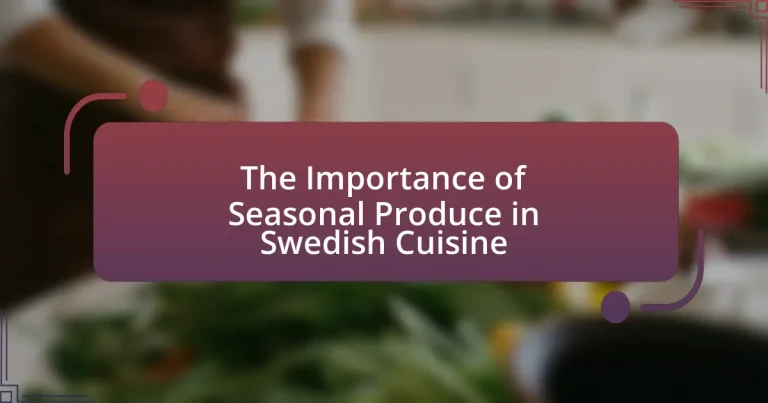The article focuses on the significance of seasonal produce in Swedish cuisine, highlighting its role in promoting freshness, sustainability, and traditional culinary practices. It discusses how seasonal ingredients influence traditional dishes, enhance flavors, and contribute to a sustainable food system by reducing carbon footprints and supporting local agriculture. The article also examines the challenges chefs face when working with seasonal produce, strategies to overcome these challenges, and the benefits for consumers who embrace seasonal cooking, including improved nutrition and lower food costs. Overall, it emphasizes the cultural and ecological importance of utilizing seasonal ingredients in Swedish culinary traditions.

What is the significance of seasonal produce in Swedish cuisine?
Seasonal produce is significant in Swedish cuisine as it emphasizes freshness, sustainability, and traditional culinary practices. The reliance on seasonal ingredients allows Swedish dishes to reflect the natural cycles of the environment, enhancing flavor and nutritional value. For instance, the use of locally sourced vegetables and fruits during their peak seasons not only supports local farmers but also reduces carbon footprints associated with transportation. Historical practices, such as preserving seasonal produce through methods like pickling and fermenting, showcase the cultural importance of utilizing what is available at different times of the year. This approach fosters a connection to the land and promotes a diet that is both varied and aligned with ecological rhythms.
How does seasonal produce influence traditional Swedish dishes?
Seasonal produce significantly influences traditional Swedish dishes by dictating the ingredients used throughout the year. For instance, root vegetables like potatoes and carrots are staples in winter dishes, while fresh berries and greens dominate summer recipes. This reliance on seasonal availability ensures that Swedish cuisine remains closely tied to local agriculture and promotes sustainability. Historical practices, such as preserving seasonal produce through pickling and fermentation, further highlight the importance of seasonal ingredients in maintaining flavor and nutrition during the long winters.
What are some examples of traditional dishes that utilize seasonal ingredients?
Traditional dishes that utilize seasonal ingredients in Swedish cuisine include gravlax, which features fresh salmon cured with salt, sugar, and dill, typically prepared in spring when salmon is abundant. Another example is sill, or pickled herring, which is often made with herring caught during the summer months. Additionally, kåldolmar, or cabbage rolls, are traditionally filled with seasonal meats and served with lingonberries, reflecting the autumn harvest. These dishes highlight the use of ingredients that are at their peak freshness and flavor during specific times of the year, emphasizing the importance of seasonal produce in Swedish culinary traditions.
How do seasonal ingredients enhance the flavors of Swedish cuisine?
Seasonal ingredients enhance the flavors of Swedish cuisine by providing freshness and optimal taste that reflects the local environment. The use of ingredients like fresh berries in summer or root vegetables in winter allows for a diverse range of flavors that are at their peak during specific times of the year. For instance, the traditional Swedish dish “kräftor” (crayfish) is celebrated in August when they are in season, offering a sweet and delicate flavor that is integral to the dish’s authenticity. Additionally, seasonal produce supports local agriculture and sustainability, ensuring that the ingredients are not only flavorful but also environmentally friendly. This connection to the seasons fosters a culinary tradition that emphasizes the importance of using what is available, resulting in dishes that are both rich in flavor and culturally significant.
Why is seasonal produce important for sustainability in Swedish cooking?
Seasonal produce is crucial for sustainability in Swedish cooking because it reduces the carbon footprint associated with transportation and storage. By utilizing ingredients that are in season locally, Swedish chefs minimize reliance on imported goods, which often require significant energy for transport. For instance, according to the Swedish Environmental Protection Agency, local sourcing of food can cut greenhouse gas emissions by up to 50%. Additionally, seasonal produce supports local farmers and promotes biodiversity, as it encourages the cultivation of a variety of crops suited to the local climate. This practice not only enhances the freshness and flavor of dishes but also contributes to a more resilient food system in Sweden.
How does using seasonal produce reduce environmental impact?
Using seasonal produce reduces environmental impact by minimizing the carbon footprint associated with transportation and storage. When fruits and vegetables are grown and consumed in their natural growing season, they require less energy for heating greenhouses and refrigeration, leading to lower greenhouse gas emissions. For example, a study by the Food and Agriculture Organization indicates that local sourcing of seasonal produce can reduce food miles by up to 90%, significantly decreasing fossil fuel consumption. Additionally, seasonal farming practices often promote biodiversity and soil health, further contributing to a more sustainable agricultural system.
What role does local sourcing play in promoting sustainability?
Local sourcing plays a crucial role in promoting sustainability by reducing transportation emissions and supporting local economies. When food is sourced locally, it typically requires less energy for transportation, which decreases greenhouse gas emissions associated with long-distance shipping. Additionally, local sourcing encourages the consumption of seasonal produce, which is often fresher and requires fewer resources for preservation and storage. According to a study by the University of California, local food systems can reduce carbon footprints by up to 25% compared to conventional food supply chains. This not only benefits the environment but also strengthens community ties and fosters economic resilience within local agricultural sectors.
How does the availability of seasonal produce affect Swedish culinary practices?
The availability of seasonal produce significantly influences Swedish culinary practices by dictating ingredient selection and preparation methods. Swedish cuisine emphasizes freshness and local sourcing, leading chefs and home cooks to adapt their menus according to what is in season. For instance, during summer, ingredients like strawberries, new potatoes, and various greens are prevalent, resulting in lighter dishes and salads. In contrast, winter months see a focus on root vegetables, preserved foods, and hearty stews, reflecting the seasonal availability of produce. This practice not only enhances flavor and nutrition but also aligns with Sweden’s cultural values of sustainability and environmental consciousness, as highlighted by the Swedish Food Agency’s promotion of seasonal eating to reduce carbon footprints.
What are the seasonal cycles for key ingredients in Sweden?
The seasonal cycles for key ingredients in Sweden are characterized by distinct growing periods influenced by the country’s climate. In spring (April to June), ingredients like asparagus, rhubarb, and early greens such as spinach and lettuce become available. Summer (June to August) sees a peak in produce, with strawberries, raspberries, and various vegetables like tomatoes and cucumbers being harvested. Autumn (September to November) brings root vegetables such as potatoes, carrots, and beets, along with apples and pears. Winter (December to March) is a time for preserved foods, as fresh produce is limited, but ingredients like cabbage and root vegetables can still be found. This seasonal availability is crucial for traditional Swedish cuisine, which emphasizes fresh, local ingredients.
How do chefs adapt their menus based on seasonal availability?
Chefs adapt their menus based on seasonal availability by incorporating fresh, locally sourced ingredients that are at their peak flavor and nutritional value. This practice not only enhances the quality of dishes but also supports local agriculture and reduces environmental impact. For instance, in Sweden, chefs often feature root vegetables in winter and fresh berries in summer, aligning their offerings with what is naturally available during each season. This approach is validated by the Swedish culinary tradition, which emphasizes the use of seasonal produce to create authentic and sustainable dishes.
What challenges do chefs face when working with seasonal produce?
Chefs face several challenges when working with seasonal produce, primarily related to availability, consistency, and quality. Seasonal produce can be unpredictable in terms of supply due to weather conditions, which can lead to shortages or surpluses. For instance, a late frost can damage crops, resulting in reduced availability of key ingredients. Additionally, the quality of seasonal produce can vary significantly, impacting the final dish’s flavor and presentation. Chefs must also adapt their menus frequently to align with the changing seasons, which can complicate planning and inventory management. This need for flexibility can strain kitchen operations and require chefs to be highly creative and resourceful in utilizing available ingredients effectively.
How do weather conditions impact the availability of seasonal ingredients?
Weather conditions significantly impact the availability of seasonal ingredients by influencing growth cycles, harvest times, and crop yields. For instance, temperature fluctuations can accelerate or delay the maturation of fruits and vegetables, while excessive rainfall can lead to crop diseases or hinder harvesting. In Sweden, the short growing season is particularly sensitive to weather variations; for example, a cold spring can delay the availability of early crops like asparagus and strawberries, while a warm summer can enhance the yield of tomatoes and cucumbers. Historical data shows that in 2018, Sweden experienced a heatwave that resulted in a bumper harvest for certain crops, demonstrating how favorable weather can enhance availability. Conversely, adverse weather events, such as frost or drought, can severely reduce the supply of seasonal ingredients, affecting both local markets and culinary practices.
What strategies do chefs employ to overcome these challenges?
Chefs employ several strategies to overcome challenges related to seasonal produce in Swedish cuisine. They prioritize sourcing local ingredients to ensure freshness and quality, which helps mitigate supply chain issues. Additionally, chefs often develop flexible menus that adapt to the availability of seasonal items, allowing them to creatively utilize what is at hand. They also engage in preserving techniques, such as pickling and fermenting, to extend the use of seasonal produce beyond its peak season. These strategies are essential for maintaining the integrity and flavor of dishes while respecting the natural growing cycles of ingredients.
How can consumers support the use of seasonal produce in Swedish cuisine?
Consumers can support the use of seasonal produce in Swedish cuisine by choosing to buy locally sourced fruits and vegetables that are in season. This practice not only promotes the consumption of fresher and more flavorful ingredients but also reduces the carbon footprint associated with transporting out-of-season produce. According to the Swedish Board of Agriculture, seasonal produce is often more affordable and supports local farmers, thereby strengthening the local economy. By participating in farmers’ markets and joining community-supported agriculture (CSA) programs, consumers can directly access seasonal offerings and encourage sustainable agricultural practices.
What are some tips for shopping seasonally in Sweden?
To shop seasonally in Sweden, prioritize local markets and seasonal produce to ensure freshness and support local farmers. Seasonal fruits and vegetables in Sweden include strawberries in summer, root vegetables in autumn, and cabbage in winter, which are often available at farmers’ markets and grocery stores. Additionally, familiarize yourself with the Swedish seasonal calendar, which indicates the best times to buy specific produce, enhancing both flavor and nutritional value. This approach not only promotes sustainability but also aligns with traditional Swedish cuisine, which emphasizes the use of seasonal ingredients for optimal taste and health benefits.
How can home cooks incorporate seasonal produce into their meals?
Home cooks can incorporate seasonal produce into their meals by planning their menus around what is currently in season, which enhances flavor and nutrition. For example, in Sweden, root vegetables like carrots and potatoes are abundant in the fall, while fresh berries are plentiful in the summer. Utilizing these ingredients not only supports local agriculture but also ensures that meals are fresher and more flavorful. Research indicates that seasonal produce is often more nutrient-dense, as it is harvested at its peak ripeness, leading to better health outcomes for consumers.
What are the benefits of embracing seasonal produce in everyday cooking?
Embracing seasonal produce in everyday cooking enhances flavor, nutrition, and sustainability. Seasonal fruits and vegetables are harvested at their peak ripeness, resulting in superior taste and higher nutrient content compared to out-of-season produce, which is often picked early and stored for long periods. For instance, a study published in the Journal of Agricultural and Food Chemistry found that seasonal produce can contain up to 50% more vitamins and minerals than non-seasonal options. Additionally, utilizing seasonal ingredients supports local farmers and reduces the carbon footprint associated with transporting food over long distances, contributing to a more sustainable food system.
How does seasonal cooking contribute to better nutrition?
Seasonal cooking contributes to better nutrition by ensuring that fruits and vegetables are consumed at their peak freshness and nutrient density. When produce is harvested in season, it is typically more flavorful and retains higher levels of vitamins and minerals compared to out-of-season produce, which may be stored for long periods or transported over long distances. Research indicates that seasonal fruits and vegetables can contain up to 50% more nutrients than those that are not in season, as they are allowed to ripen naturally and are consumed shortly after harvest. This practice not only enhances the nutritional quality of meals but also supports local agriculture and reduces the carbon footprint associated with food transportation.
What impact does seasonal produce have on food costs?
Seasonal produce significantly lowers food costs due to its abundance and reduced transportation expenses. When fruits and vegetables are in season, they are typically harvested at peak ripeness, leading to higher yields and lower prices in local markets. For example, a study by the USDA found that seasonal fruits can be up to 30% cheaper than out-of-season varieties, as they do not require costly imports or extensive refrigeration. This economic advantage encourages consumers to purchase more local and seasonal items, further driving down costs and supporting local agriculture.




